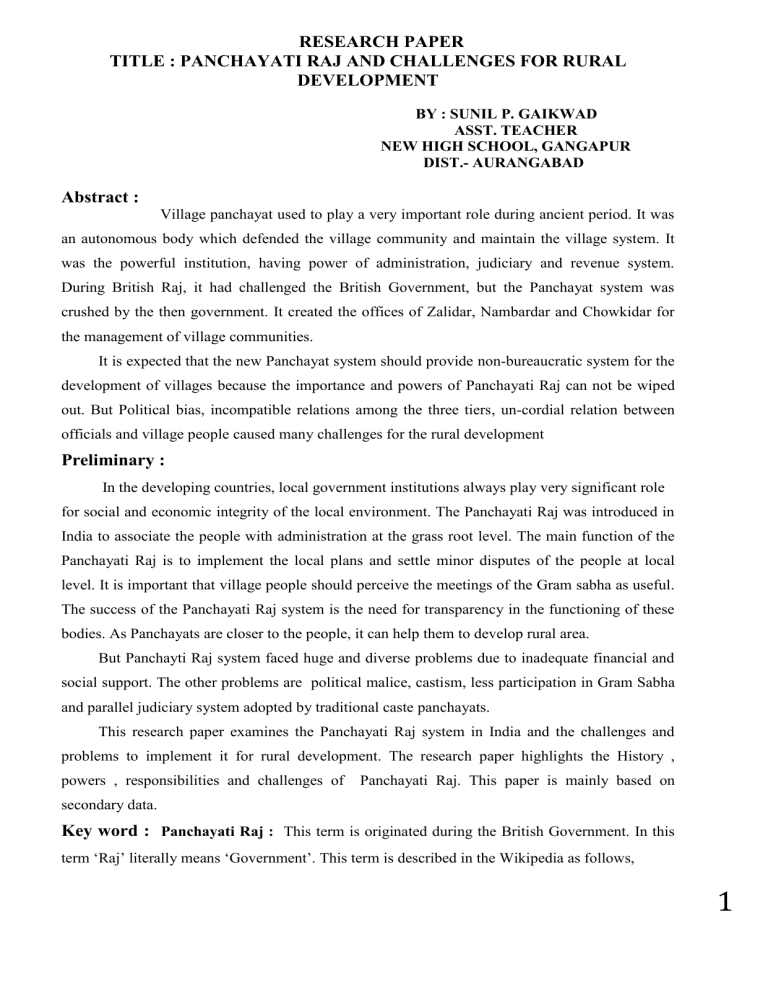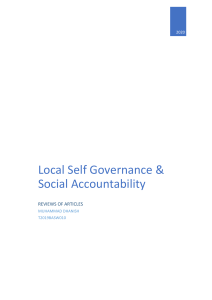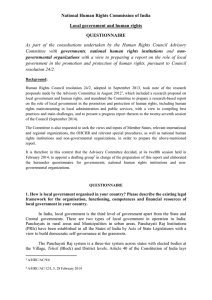
RESEARCH PAPER TITLE : PANCHAYATI RAJ AND CHALLENGES FOR RURAL DEVELOPMENT BY : SUNIL P. GAIKWAD ASST. TEACHER NEW HIGH SCHOOL, GANGAPUR DIST.- AURANGABAD Abstract : Village panchayat used to play a very important role during ancient period. It was an autonomous body which defended the village community and maintain the village system. It was the powerful institution, having power of administration, judiciary and revenue system. During British Raj, it had challenged the British Government, but the Panchayat system was crushed by the then government. It created the offices of Zalidar, Nambardar and Chowkidar for the management of village communities. It is expected that the new Panchayat system should provide non-bureaucratic system for the development of villages because the importance and powers of Panchayati Raj can not be wiped out. But Political bias, incompatible relations among the three tiers, un-cordial relation between officials and village people caused many challenges for the rural development Preliminary : In the developing countries, local government institutions always play very significant role for social and economic integrity of the local environment. The Panchayati Raj was introduced in India to associate the people with administration at the grass root level. The main function of the Panchayati Raj is to implement the local plans and settle minor disputes of the people at local level. It is important that village people should perceive the meetings of the Gram sabha as useful. The success of the Panchayati Raj system is the need for transparency in the functioning of these bodies. As Panchayats are closer to the people, it can help them to develop rural area. But Panchayti Raj system faced huge and diverse problems due to inadequate financial and social support. The other problems are political malice, castism, less participation in Gram Sabha and parallel judiciary system adopted by traditional caste panchayats. This research paper examines the Panchayati Raj system in India and the challenges and problems to implement it for rural development. The research paper highlights the History , powers , responsibilities and challenges of Panchayati Raj. This paper is mainly based on secondary data. Key word : Panchayati Raj : This term is originated during the British Government. In this term ‘Raj’ literally means ‘Government’. This term is described in the Wikipedia as follows, 1 The Panchayat raj is a South Asian political system mainly in India, Pakistan, Bangladesh and Nepal. It is the oldest system of local government in the Indian sub continent. The word ‘Panchayat’ means ‘assembly’( ayat ) of five ( panch ) wise and respected elders chosen and accepted by the local community. However there are different forms of assemblies. Traditionally these assemblies settled disputes between and village. Wikipedia/Panchayati Raj : 1 History of Panchayati Raj : Balwant Rai Mehta committee was appointed by the Government of India to examine and give suggestions for the better working of community development programme. The The committee created a three-tier structure of panchayats and it was given the name of Panchayati Raj. Gram Sabha and Gram Panchayat were included in it at village level, Panchayat Samiti at the Block level and Zilla Parishad at the district level. Panchayati Raj was inaugurated by the first prime minister of India, Pandit Jawaharlal Nehru at Nagpur ( Rajasthan ) on Oct.2,1959. Aims and Objectives of Panchayati Raj : Most of the countries are realizing the importance of local governance for rural development. Currently, Panchayati Raj system exists in all the states of India except Nagaland and Mizoram. Following objectives are set to strengthen the system, - It helps in the rise of civic consciousness among the villagers. - to shift the centre of gravity to the villagers. - to bring the change in the administrative set up. Powers and Responsibilities Of Panchayati Raj : As referred above, village panchayat settled minor disputes at local level and performed the maintenance of roads, schools, public health, sanitation, street light and community centers. It also takes some necessary steps for the development of agriculture. Panchayati Raj system was given some powers and responsibilities by the Govt. of India. They are described in Wikipedia as follows, Preparation of economic development plan and social justice plan. Implementation of schemes for economic development and social justice in relation to 29 subjects given in the Eleventh schedule of the Constitution. To levy and collect appropriate taxes, duties, tolls and fees. Wikipedia/Panchayati Raj: 2 2 Local development depends on how well the Panchayats are empowered with the funds and functions panchayats were given. Some Major Problems : Incompetent Leadership : Village development is neglected, when the members of Panchayats are elected. All the schemes transferred from State Government are beneficial to the political parties and local leaders. Panchayati Raj system won’t succeed, unless people are aware of their rights and responsibilities. Casteism : Though seats are reserved for the representatives of women, scheduled castes and scheduled tribes, it is seen that higher class people always dominated in the politics of Panchayats. Most of the disputes are related to the casteism in the villages. Poverty : The challenge of rural poverty cannot be met without the active involvement of Panchayati Raj. Panchayats are looked upon as a means to achieve socio-economic transformation of our rural societies. It is seen that the socio-economic benefits of Panchayati Raj have not gone to the weaker sections and these sections of community are kept oppressed and suppressed. Participation of weaker sections : At the village Panchayat level, the participation of weaker sections are not satisfactory. They are the passive participants in its meetings and proceedings. This is so because they lack essential requisites like education and income. Co-relations of officials and villagers : Villagers are not well satisfied with the Panchayati Raj system and it’s functions, as it is not beneficial to them. They feel insecure and come with many complaints. Officials should co-operate them. Suggestions : Following suggestions are given to strengthen and overcome the problems and challenges of Panchayati Raj Institutions, - the Panchayati Raj Institutions should be strengthened economically and socially. - As the Panchayati Raj systems builds at grassroots, it is the duty of the Government to see that the system is using legitimacy properly. - Panchayats should solve all the minor disputes at local level. - There should be a co-relation between officials and villagers. - Participation of women, SC and ST members in the Gram sabha should be made mandatory with suitable provision for their presence in the quorum of Gram Sabha meetings. 3 - a need for the transparency in the functioning of Panchayats. - The Centre and State should make provisions for training Panchayat representatives. Conclusions : Local development depends on how well the Panchayats are empowered with funds and functions. Panchayats are also playing an important role in the implementation of anti-poverty programme. There should be an equality not only between men and women representatives but also between officials and non-officials for the development structure. The real issues are knowledge and awareness of the needs of the people and their rights. Strong leadership and political will are also necessary to face the challenges of Panchayats to become effective instrument of social and economic development of rural areas. WORK CITED 1. Bhagrgava, B.S.,1979, Panchayati Raj Institutions, An Analysis of Issues, Problems and Recommendations of Asoka Mehta Committee, Ashish Publishing House, New Delhi, Pin.110027. 2. Gurumurthy, U., 1987, Panchayati Raj and the Weaker Sections, Ashish Publishing House, New Delhi, Pin 110027. 3 Patil, V.B., 2009, Panchayat Raj, Prashant Publicatons, Jalgaon, 425001. WEB PAGES 1 http://en.wikipedia.org/wiki/panchayatiraj as on 20/3/2013 2 www.unescap.org/ttdw/Publications/TPTS_pubs/TxBulletin_69/bu .. on 20/3/2013 ARTICLES 1 Village Democracy for “Inclusive Governance”, Chronicle, Vol.XXIV No.3, Sept.2012, Pg. 104-135. 4 5






